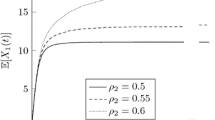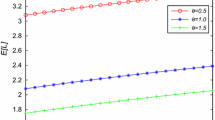Abstract
This paper studies a new type of multi-class priority queues with semi-exhaustive service and server vacations, which operates as follows: A single server continues serving messages in queuen until the number of messages decreases toone less than that found upon the server's last arrival at queuen, where 1≤n≤N. In succession, messages of the highest class present in the system, if any, will be served according to this semi-exhaustive service. Applying the delay cycle analysis and introducing a super-message composed of messages served in a busy period, we derive explicitly the Laplace-Stieltjes transforms (LSTs) and the first two moments of the message waiting time distributions for each class in the M/G/1-type priority queues with multiple and single vacations. We also derive a conversion relationship between the LSTs for waiting times in the multiple and single vacation models.
Similar content being viewed by others
References
O.J. Boxma and W.P. Groenendijk, Pseudo-conservation laws in cyclic-service systems, J. Appl. Prob. 24 (1987) 949–964.
Y.Z. Cho and C.K. Un, Analysis of theM/G/1 queue under a combined preemptive/nonpreemptive priority discipline, IEEE Trans. Commun. 41 (1993) 132–141.
J.W. Cohen, A two-queue model with semi-exhaustive alternating service,Performance '87, eds. P.-J. Courtois and G. Latouche (North-Holland, 1988).
B.T. Doshi, Single server queues with vacations,Stochastic Analysis of Computer and Communication Systems, ed. H. Takagi (North-Holland, 1990).
I.M. Dukhovnyi, A single-channel queueing system with alternating priority, Problems of Inf. Transmission 5 (1969) 47–55.
N.K. Jaiswal,Priorities Queues (Academic Press, New York, 1968).
T. Katayama, Performance analysis for a two-class priority queueing model with general decrementing service, IEICE Trans. Commun. E75-B (1992) 1301–1307.
T. Katayama, Analysis of an alternating priority queue with general decreasing service and with setup times or server vacations,Proc. Int. Conf. on Local and Metropolitan Communication Systems, eds. T. Hasegawa et al., Kyoto, Japan (1994) pp. 481–500. (To be published as “Local Metropolitan Communication Systems” by Chapman & Hall).
O. Kella and U. Yechiali, Priorities inM/G/1 queue with server vacations, Naval Res. Logist. Quart. 35 (1988) 23–34.
B.G. Pittel', Optimal control in a mass service system with several flows of demands, Eng. Cybernetics 11 (1972) 1029–1044.
H. Takagi, Mean message waiting time in a symmetric polling system,Performance'84, Models of Computer System Performance, ed. Gelenbe (North-Holland, 1985).
H. Takagi,Queueing Analysis: A Foundation of Performance Evaluation, Vol. 1, Vacation and Priority Systems, Part 1 (Elsevier, North-Holland, 1991).
Y. Takahashi and S. Shimogawa, Composite priority single-server queue with structured batch inputs, Commun. Stat.-Stoch. Models 7 (1991) 481–497.
V.P. Vinnitskii and G.L. Brodetskii, Alternating priorities and Rest periods in a single-server queueing system, Cybernetics 9 (1973) 321–327.
Author information
Authors and Affiliations
Rights and permissions
About this article
Cite this article
Katayama, T. Priority queues with semi-exhaustive service. Queueing Syst 21, 161–181 (1995). https://doi.org/10.1007/BF01158579
Received:
Revised:
Issue Date:
DOI: https://doi.org/10.1007/BF01158579




